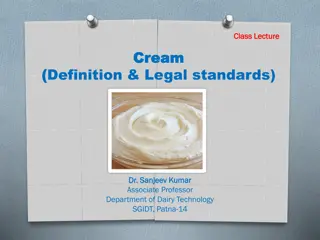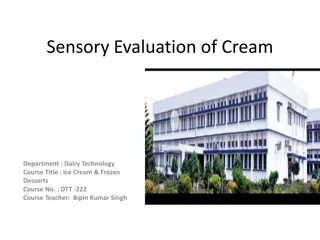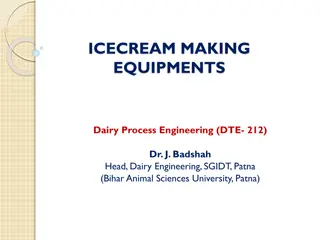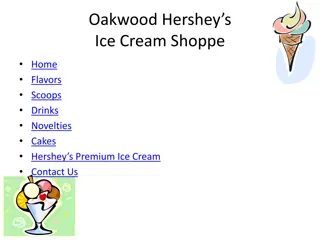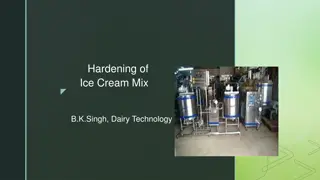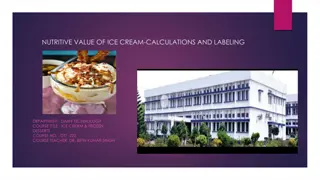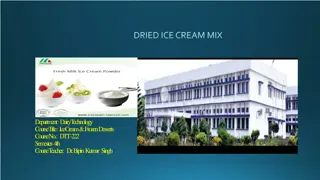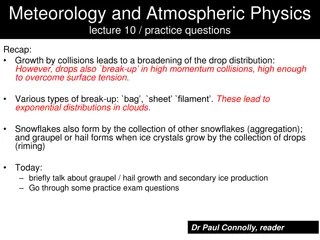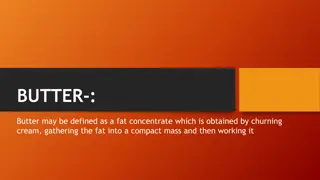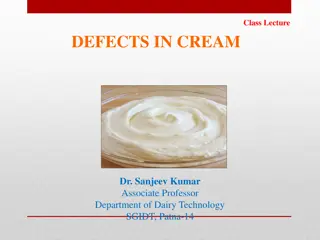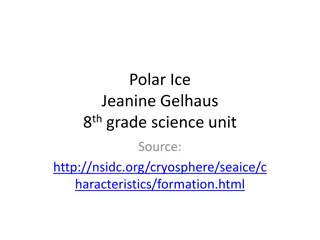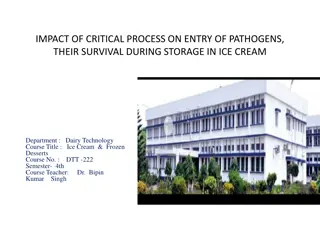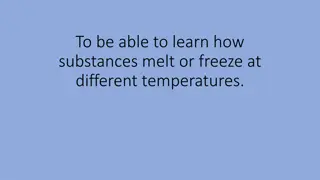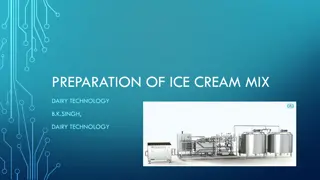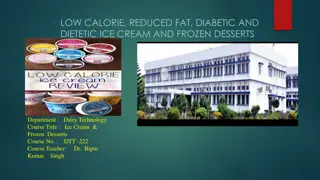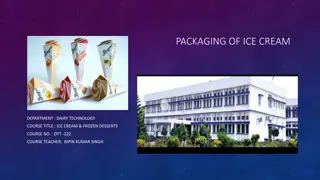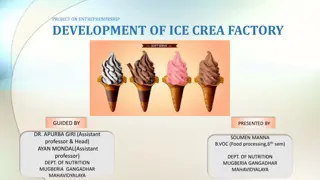Understanding the Freezing Process in Ice Cream Production
The freezing process is crucial in ice cream production as it determines the quality, texture, and overall appeal of the final product. This process involves quick freezing of the mix while incorporating air to create small ice crystals for smoothness. Factors like freezer type, mix composition, and freezing conditions impact the freezing time and overall ice cream quality. Learn about the objectives, factors, and changes during the freezing process to achieve the perfect ice cream consistency.
Download Presentation

Please find below an Image/Link to download the presentation.
The content on the website is provided AS IS for your information and personal use only. It may not be sold, licensed, or shared on other websites without obtaining consent from the author. Download presentation by click this link. If you encounter any issues during the download, it is possible that the publisher has removed the file from their server.
E N D
Presentation Transcript
ICE CREAM FREEZING & FREEZERS B.K.SINGH, DAIRY TECHNOLOGY
FREEZING Freezing the mix is one of the most important steps in making ice cream, since it decides the quality, palatability, and yield of the finished product. Freezing process may be divided into two parts: 1) The mix, with the proper amount of colour and flavouring agents generally added to the freezer, is quickly frozen while being agitated to incorporate air in such a way as to produce and control formation of the small ice crystals that are necessary to give smoothness in body and texture, palatability and satisfactory overrun in the finished ice cream. 2) When ice cream is partially frozen to the proper consistency, it is drawn from the freezer into packages and quickly transferred to cold storage rooms, where the freezing and hardening process is completed without agitation.
Objectives of freezing To achieve partial freezing of the product Incorporation of air to give a fine, uniform and stable foam A partial churning of the fat emulsion (in presence of emulsifier)
Factors affecting Freezing Time Mechanical Type and make of freezer Condition of freezer wall and blades Speed of dasher Temperature of refrigerant Velocity of refrigerant passing around freezing chamber Overrun desired Temperature at which ice cream is drawn Rateat which freezer is unloaded. a) b) c) d) e) f) g) h)
Factors affecting Freezing Time Character of mix a)Composition of mix b) Freezing point of mix c) Acidity content of ingredients d) Kind of ingredients, particularly those carrying fat e) Methods by which the mix is processed f) Kind and amount of flavoring materials added
Changes during freezing process Lowering the temperature of the mix from ageing temperature to the freezing point Freezing a portion of water in the mix Incorporating air into the mix Cooling ice cream from the temperature at which it is drawn from the freezer to hardening room temperature.
Freezers Freezers used in freezing of ice cream mix classified as follows Batch freezer: Horizontal, direct expansion type Continuous freezer: Horizontal, direct expansion type Soft serve freezer: Batch and automatic continuous freezers of the direct expansion type a) b) c)
Batch freezer Batch freezer is a machine used to commercially produce large volumes of ice cream, gelato, sorbet, frozen custard, and sherbet. In this freezer, the product mix (also called the base) is frozen and whipped simultaneously to create the frozen desserts. a smooth consistency in Preparation of the freezer Addition of ice cream mix Incorporation of particulate inclusions
Cleaning and sanitizing the freezer After the ice cream is emptied from the freezer, the freezer barrel is filled with successive portions of cold and lukewarm (145o F) water. Add suitable amount of washing powder to the water after rinsing is over. Just a touch of motor switch to give scraper one or two revolutions in the freezer is desirable. Remove the dasher assembly for thorough washing.
Freezing control devices in batch freezer Willman controller: This device is used to indicate refrigeration off point and the correct overrun point . Draw-Rite controller
Continuous freezer In this system, the mix and air are fed into the ice cream freezer by arranging two feed pumps in series, with an air inlet valve between them. The first pump regulates the rate of mix flow while the second one operates at a higher speed than the first. This together with regulation of inlet valve, controls the quantity of air drawn into the mix and provides the pressure for forcing the mixture through the freezer barrel.
CIP of continuous freezer Rinse with water ( Flush for 20-30 min with 150-160o F water containing 0.5-0.7% alkali strength detergent. Rinse until the equipment is cooled. When using acid cleaner, circulate cleaning solution containing sufficient acid (phosphoric and hydroxyacetic acid) to give 0.5-0.6% acidity, at 150-160o F and 5-7.5 ft./sec velocity for 20-30 min. Drain and rinse with water at 145o F for 5-7 min. The freezer is made to run 10 sec for every 10 min. of cleaning operation. 100o F) until the rinse water runs clear.
Soft serve Soft serve is a frozen dairy dessert, similar to ice cream but softer and less dense as a result of air being introduced during freezing. Soft serve has been sold commercially since the late 1930s in the US. Soft serve is generally lower in milk-fat (3 to 6 percent) than ice cream(10 to 18 percent) and is produced at a temperature of about 4 C (25 F) compared to ice cream, which is stored at 15 C (5 F). Soft serve contains air, introduced at the time of freezing. The air content, called overrun, can vary from 0 to 60 percent of the total volume of finished product. The amount of air alters the taste of the finished product. Product with low quantities of air has a heavy, icy taste and appears more yellow.
Structure of frozen ice cream The dispersion and emulsion consist primarily of a freeze-concentrated aqueous serum phase containing sugar and the dry matter contents surrounding dispersed ice crystals and fat globules. Ice crystals range in size from ~ 1 to > 150 m in diameter, with an average size of 35 m. Fat globules are 2 m in diameter. The foam is formed by pockets of air (~ 20 to 50 m diameter) dispersed throughout the emulsion and is supported by partially coalesced fat globules. In Low-temperature freezing , the ice crystal size may be reduced as much as 40% e.g. from 45- 55 um to 18-22 m. The air cell size seems to remain about the same or become a little larger, but the number of air cells increases slightly in number. The air cell wall thickness is just 50-100 m in ice cream frozen in normal continuous freezer. Ice crystal size is also important to ice cream shelf life. As the ice cream sits in storage, the ice crystals continually grow by recrystallization. The temperature fluctuations seen in a frost-free home freezer serve to accelerate this process. m as against 100-150


